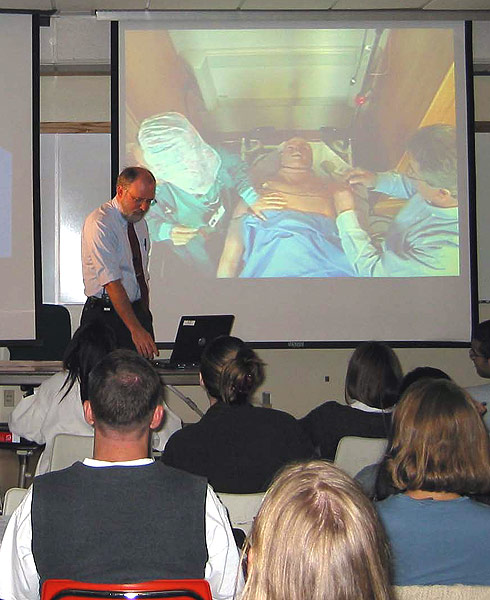 |
|
Dr. Fleming, M.D., Associate Professor in the department of Anesthesiology, leads his students
through an online anesthesia administration to their virtual patient, "Stan".
Photo by Jeff van de Pol |
"Uh oh. I think we killed Stan," said a worried medical student to her classmate as she searched
for visible signs of life in the seemingly still patient. A quick review of the vital signs
monitor ensued, showing that all was well. After a closer look at the patient, the procedure
continued, and Stan's 100 doctors, who were all 20 miles away, collectively breathed a sigh of
relief.
In a preview of the possible
future of medical education,
a large group of students
in Dr. Fleming's Anesthesiology
class used a high-speed video
network link between the campus
and the UC
Davis Medical Center (UCDMC)
to remotely decide upon a
course of anesthesia, direct
the process on "Stan"--an
advanced human patient simulator
mannequin--and view the effects
in real time.
The result of extensive collaboration between
the School of Medicine, UCDMC,
and Information
and Educational Technology (IET),
the remote human patient simulation
proved extremely popular among
students.
Breaking New Ground
Mindful of the significant distance students must routinely travel between UCDMC (in Sacramento)
and the campus, the School of Medicine began searching for innovative ways to allow for easier
collaboration. Space for these kinds of demonstrations at the Medical Center is another
challenge that school officials were eager to overcome.
"In the past, sessions like these have been limited to 5-10 people who could manage to squeeze
into the demonstration space," shared Paul Ver Wey, head of the IET Mediaworks Video Group
involved in the project. "Instructional videos were helpful, but did not allow for any real-time
interaction between the viewers and those involved in the procedure."
To overcome these challenges,
the School of Medicine worked
extensively with the UC
Davis Health System (UCDHS)
Network Operations Group
and two IET departments, Communications
Resources (CR) and Mediaworks.
Collectively, they developed
a two-way real-time video
link between the campus and
the Medical Center.
This type of link between the two facilities had never before been attempted over an IP network.
"We never have done a large video stream to and from campus, so we had to continually monitor
bandwidth usage to ensure a smooth image and sound," said Daniel Keister, a Senior Network
Engineer with UCDHS Network Operations. "I worked with the video encoder/decoders to compress
video and audio and sent it across our IP network to the other encoder/decoder on campus."
At the Medical Center, an IET Mediaworks video crew provided three different views of the remote
operating room: side and overhead views of Stan, along with a full-screen view of the machine
hooked up to Stan that displayed his vital signs. An IET Mediaworks video crew also set up
cameras in Dr. Fleming's classroom in Tupper Hall, where two projector screens displayed Dr.
Fleming's PowerPoint lecture and the live images of Stan.
"With everything in place, Dr. Fleming and his students were able to switch between the views as
needed, and converse with Dr. Wong, who oversaw the anesthesia administration on-site," shared
Ver Wey.
Students Like Their Virtual Patient
The students as a whole seemed to enjoy the interactive aspects of the two-way video link. "This
is a good way to see the practical use of the material we're learning," said Ravjeet Kullar, a
second-year medical student. "We're more likely to remember when we're taught in an interactive
way."
The class members were also big fans of the advanced human patient mannequin (nicknamed 'Stan'),
which accurately simulated the effects the students' anesthetic choices would have on a live
patient. "It was nice seeing the connection between what we were learning and real medicine,"
said Kullar. "We felt more engaged since we could immediately see the results of our anesthetic
choice." The students watched on as Stan's vital signs changed, his breathing rate fluctuated,
or his muscles twitched in response to the anesthetic the students chose to administer to him.
The Future Looks Bright
Future plans bode well for collaborative projects like this, as Communications Resources, working
with CENIC (Corporation for Education Network Initiatives in California,
http://www.cenic.org/),
is now installing equipment for the Optical Network Infrastructure (ONI) initiative, a project
that will greatly enhance the networking speed available to higher education on the West Coast.
Once completed (the second phase will take approximately one year), both the Medical Center and
UC Davis will have direct access to each other and to the high speed ONI infrastructure. "This
will enable the campus and the UC Davis Health System to use HDTV (High Definition TV) and other
advanced technologies between us without impacting the IP data network," shared Keister. "I
think it has great potential, as it gives students the ability to see and hear real world medical
procedures without having to travel."
One other suggestion for
future distance learning medical
education is an unexpected
but enlightening one: the
students actually want longer
classes. "I would've appreciated
having a two-hour lecture
rather than just one hour,"
said Kullar.
Send us your comments on this story.
¤